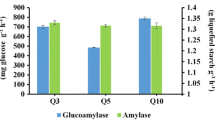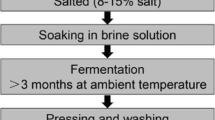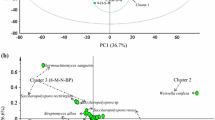Abstract
The vinegar pei harbors complex bacterial communities. Prior studies revealing the bacterial diversity involved were mainly conducted by culture-dependent methods and PCR–DGGE. In this study, 454 pyrosequencing was used to investigate the bacterial communities in vinegar pei during the acetic acid fermentation (AAF) of Tianjin Duliu aged vinegar (TDAV). The results showed that there were 7 phyla and 24 families existing in the vinegar pei, with 2 phyla (Firmicutes, Protebacteria) and 4 families (Lactobacillaceae, Acetobacteracae, Enterobacteriaceae, Chloroplast) predominating. The genus-level identification revealed that 9 genera were the relatively stable, consistent components in different stages of AAF, including the most abundant genus Lactobacillus followed by Acetobacter and Serratia. Additionally, the bacterial community in the early fermentation stage was more complex than those in the later stages, indicating that the accumulation of organic acids provided an appropriate environment to filter unwanted bacteria and to accelerate the growth of required ones. This study provided basic information of bacterial patterns in vinegar pei and relevant changes during AAF of TDAV, and could be used as references in the following study on the implementation of starter culture as well as the improvement of AAF process.




Similar content being viewed by others
References
Caporaso JG, Bittinger K, Bushman FD, DeSantis TZ, Andersen GL, Knight R (2010) PyNAST: a flexible tool for aligning sequences to a template alignment. Bioinformatics 26:266–267
Caporaso JG, Kuczynski J, Stombaugh J et al (2010) QIIME allows analysis of high-throughput community sequencing data. Nat Methods 7:335–336
Chen Q, Liu A, Zhao J, Ouyang Q, Sun Z, Huang L (2013) Monitoring vinegar acetic fermentation using a colorimetric sensor array. Sensor Actuat B 183:608–616
Cole JR, Chai B, Farris RJ, Wang Q, Kulam SA, McGarrell DM, Garrity GM, Tiedje JM (2005) The Ribosomal Database Project (RDP-II): sequences and tools for high-throughput rRNA analysis. Nucleic Acids Res 33:D294–D296
De Vero L, Gala E, Gullo M, Solieri L, Landi S, Giudici P (2006) Application of denaturing gradient gel electrophoresis (DGGE) analysis to evaluate acetic acid bacteria in traditional balsamic vinegar. Food Microbiol 23(8):809–813
Ducic M, Blagojevic B, Markov S, Velicanski A, Buncic S (2014) General patterns of background microbiota and selected bacterial pathogens during production of fermented sausages in Serbia. Food Control 43:231–237
Ercolini D, Filippis FD, Storia AL, Iacono M (2012) A‘remake’of the microbiota involved in the production of water buffalo mozzarella cheese by high throughput sequencing. Appl Environ Microbiol 78:5717–5723
Griffin AT, Christensen D (2014) Fusobacterium spondylodiscitis: case report and literature review. Diagn Micr Infect Dis 78(4):491–493
Gullo M, Caggia C, De Vero L, Giudici P (2006) Characterization of acetic acid bacteria in “traditional balsamic vinegar. Int J Food Microbiol 106(2):209–212
Gullo M, Giudici P (2008) Acetic acid bacteria in traditional balsamic vinegar: phenotypic traits relevant for starter cultures selection. Int J Food Microbiol 125(1):46–53
Haruta S, Ueno S, Egawa I, Hashiguchi K, Fujii A, Nagano M, Ishii M, Igarashi Y (2006) Succession of bacterial and fungal communities during a traditional pot fermentation of rice vinegar assessed by PCR-mediated denaturing gradient gel electrophoresis. Int J Food Microbiol 109(1–2):79–87
Hasseltvedt V, Caugant D (2012) Bacteraemia caused by genus Oligella. Int J Infect Dis 16:222–223
Ilabaca C, Navarrete P, Mardones P, Romero J, Mas A (2008) Application of culture culture-independent molecular biology based methods to evaluate acetic acid bacteria diversity during vinegar processing. Int J Food Microbiol 126(1–2):245–249
Kim YS, Kim MC, Kwon SW, Kim SJ, Park IC, Ka JO, Weon HY (2011) Analyses of bacterial communities in meju, a Korean traditional fermented soybean bricks, by cultivation-based and pyrosequencing methods. J Microbiol 49(3):340–348
Leite AM, Mayo B, Rachid CT, Peixoto RS, Silva JT, Paschoalin VM, Delgado S (2012) Assessment of the microbial diversity of Brazilian kefir grains by PCR-DGGE and pyrosequencing analysis. Food Microbiol 31(2):215–221
Lü X, Hu P, Dang Y, Liu B (2014) Purification and partial characterization of a novel bacteriocin produced by Lactobacillus casei TN-2 isolated from fermented camel milk (Shubat) of Xinjiang Uygur Autonomous region, China. Food Control 43:276–283
Lü X, Yi L, Dang J, Dang Y, Liu B (2014) Purification of novel bacteriocin produced by Lactobacillus coryniformis MXJ 32 for inhibiting bacterial foodborne pathogens including antibiotic-resistant microorganisms. Food Control 46:264–271
Matsutani M, Nishikura M, Saichana N, Hatano T, Masud-Tippayasak U, Theergool G, Yakushi T, Matsushita K (2013) Adaptive mutation of Acetobacter pasteurianus SKU1108 enhances acetic acid fermentation ability at high temperature. J Biotechnol 165(2):109–119
Mills S, Sullivan O, Hill C, Fitzgerald G, Ross RP (2010) The changing face of dairy starter culture research: from genomics to economics. Int J Dairy Technol 63:149–170
Nam YD, Lee SY, Lim SI (2012) Microbial community analysis of Korean soybean pastes by next-generation sequencing. Int J Food Microbiol 155(1–2):36–42
Nie ZQ, Zheng Y, Wang M, Han Y, Wang Y, Luo J, Niu D (2013) Exploring microbial succession and diversity during solid-state fermentation of Tianjin duliu mature vinegar. Bioresour Technol 148:325–333
Park JE, Kim JY, Kim J, Kim YJ, Kim MJ, Kwon SW, Kwon O (2014) Pomegranate vinegar beverage reduces visceral fat accumulation in association with AMPK activation in overweight women: a double-blind, randomized, and placebo-controlled trial. J Funct Foods 8:274–281
Pedraza RO (2008) Recent advances in nitrogen-fixing acetic acid bacteria. Int J Food Microbiol 125(1):25–35
Qi Z, Yang H, Xia X, Xin Y, Zhang L, Wang W, Yu X (2013) A protocol for optimization vinegar fermentation according to the ratio of oxygen consumption versus acid yield. J Food Eng 116(2):304–309
Qi Z, Yang H, Xia X, Quan W, Wang W, Yu X (2014) Achieving high strength vinegar fermentation via regulating cellular growth status and aeration strategy. Process Biochem 49(7):1063–1070
Solieri L, Giudici P (2008) Yeasts associated to traditional balsamic vinegar: ecological and technological features. Int J Food Microbiol 125(1):36–45
Storm JC, Ford BA, Streit JA (2013) Myocardial infection due to Fusobacterium nucleatum. Diagn Microbiol Infect Dis 77(4):373–375
Vegas C, González Á, Mateo E, Mas A, Poblet M, Torija MJ (2013) Evaluation of representativity of the acetic acid bacteria species identified by culture-dependent method during a traditional wine vinegar production. Food Res Int 51(1):404–411
Vijay Simha B, Sood SK, Kumariya R, Garsa AK (2012) Simple and rapid purification of pediocin PA-1 from Pediococcus pentosaceous NCDC 273 suitable for industrial application. Microbiol Res 167(9):544–549
Wang Z, Yan M, Chen X, Li D, Qin L, Li Z, Yao J, Liang X (2013) Mixed culture of Saccharomyces cerevisiae and Acetobacter pasteurianus for acetic acid production. Biochem Eng J 79:41–45
Wang SL, Lin CL, Liang TW, Liu KC, Kuo YH (2009) Conversion of squid pen by Serratia ureilytica for the production of enzymes and antioxidants. Bioresour Technol 100(1):316–323
Wilmer A, Wong P, Press N, Leung V, Romney M, Champagne S (2013) Oligella urethralis as a cause of urosepsis. Clin Microbiol Newsl 35(10):84–85
Wu JJ, Ma YK, Zhang FF, Chen FS (2012) Biodiversity of yeasts, lactic acid bacteria and acetic acid bacteria in the fermentation of “Shanxi aged vinegar”, a traditional Chinese vinegar. Food Microbiol 30(1):289–297
Wu JJ, Gullo M, Chen FS, Giudici P (2010) Diversity of Acetobacter pasteurianus strains isolated from solid-state fermentation of cereal vinegars. Curr Microbiol 60:280–286
Xiao X, Dong Y, Zhu Y, Cui H (2013) Bacterial diversity analysis of Zhenjiang Yao meat during refrigerated and vacuum-packed storage by 454 pyrosequencing. Curr Microbiol 66(4):398–405
Xu W, Huang Z, Zhang X, Li Q, Lu Z, Shi J, Xu Z, Ma Y (2011) Monitoring the microbial community during solid-state acetic acid fermentation of Zhenjiang aromatic vinegar. Food Microbiol 28(6):1175–1181
Acknowledgements
This study was supported by the Science and Technology Program of Tianjin (13ZCDNC01900). We would like to thank Miss Jin Wang, Miss Xin Zhao, Miss Xiqian Tan, and Mr. Jiping Wei for their advice and help.
Author information
Authors and Affiliations
Corresponding author
Rights and permissions
About this article
Cite this article
Peng, Q., Yang, Y., Guo, Y. et al. Analysis of Bacterial Diversity During Acetic Acid Fermentation of Tianjin Duliu Aged Vinegar by 454 Pyrosequencing. Curr Microbiol 71, 195–203 (2015). https://doi.org/10.1007/s00284-015-0823-9
Received:
Accepted:
Published:
Issue Date:
DOI: https://doi.org/10.1007/s00284-015-0823-9




